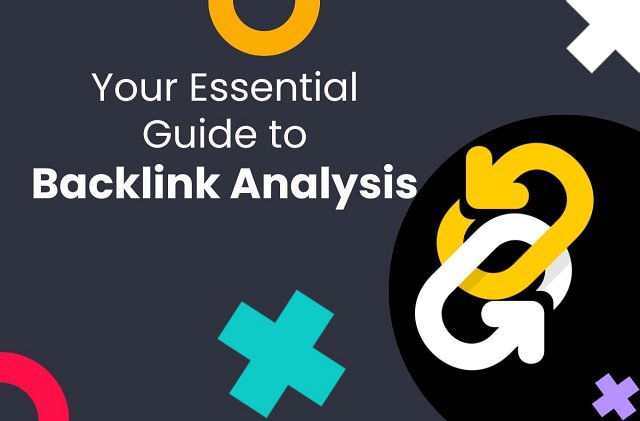(16 min. read)

Imagine yourself as a detective, assigned with the task of uncovering the secrets behind a website’s success on search engine results pages (SERPs). Your go-to tool? Backlink analysis. In the world of SEO, conducting such audit involves thoroughly examining all links pointing to a particular site. This process helps assess its performance and identify potential issues affecting its search engine rankings. It also reveals strategic opportunities for improvement - essentially serving as a comprehensive health check for your website’s backlinks.
One might wonder why backlink analysis is such a crucial aspect in maintaining one’s online presence. The answer lies within how search engines operate. They tend to favor high-quality inbound links from reputable and relevant websites when determining rankings. This means that regularly analyzing your backlinks can greatly impact your authority and visibility on SERPs. Furthermore, it plays an essential role in staying updated with changes, updating ranking signals, and discovering new ways to boost your position. Hence, making it an integral part of managing one’s domain effectively.
What is a backlink analysis?
The concept of backlink analysis can be likened to an X-ray for your website’s backlink profile. It provides a comprehensive view of:
-
all the inbound links from other websites that direct traffic towards yours
-
these incoming links are considered by search engines as indicators of your site’s credibility and authority.
These are essentially votes of confidence in the content on your website, coming from external sources.
It is not just about quantity but also quality when it comes to backlinks. Through this type of analysis, you can assess the value and relevance attached to your content based on endorsements from third-party sites, a clear reflection of how authoritative they perceive your website to be. In essence, conducting a thorough examination using backlink analysis allows you to gain insights into who is linking with or referring traffic to your site. Their methods used for link-building. And even what kind words may have been said about it - essentially revealing the ‘who’, ‘how’, and ‘what’ aspects pertaining to building up a strong network through inbound links directed at boosting SEO rankings via organic search engine results pages (SERPs).
Why does backlink analysis matter?
Backlink analysis is a crucial aspect of SEO that should not be underestimated. The importance of backlinks can be likened to the role bridges play in connecting different places, and similarly, high-quality links are essential for users and search engines to easily find and navigate your website. Through analyzing backlinks, you can identify these valuable connections that ultimately contribute to improving your site’s rank on search engine results.
But it goes beyond just identifying top-notch links. Conducting thorough backlink analysis also helps ensure diversity in your backlink profile, an important factor when it comes to optimizing for search engines. It allows you to pinpoint potentially harmful toxic links while verifying the relevance and quality of others. Plus, understanding how nofollow links work is key as well as ensuring natural use of anchor text within them.
A tool like a reliable backlink checker proves useful when performing this comprehensive examination process aimed at boosting rankings on SERPs (search engine result pages). In essence, through its various features, such as detecting low-quality or irrelevant sources among other helpful tools offered by this “Swiss Army knife” approach. Enhancing one’s overall presence online becomes achievable with ease.
Essential Tools for Backlink Analysis
Like a detective needs the right tools for their investigation, performing a backlink analysis also requires specific instruments. These aids are vital in tasks such as identifying backlinks, researching competitors’ profiles, locating broken links, and studying anchor text distribution.
So what are the must-have tools for your SEO toolkit when it comes to conducting a thorough backlink analysis? Google Search Console, Ahrefs, and Moz top the list of essential resources. Each tool offers its own set of features and insights that can greatly assist you in optimizing your website’s backlink profile. It is important not to settle for surface-level understanding. Rather dive deeper into how these tools can contribute to your journey through analyzing backlinks.
Google Search Console
At the top of our list is Google Search Console, a free tool offered by the search engine giant itself. This valuable resource provides crucial insights into your website’s backlink profile and allows you to see which external sites are linking to yours. It essentially gives you direct access to how Google views your site.
The “Links” section within Google Search Console presents an in-depth report on all backlinks pointing to your site. It offers essential metrics for evaluating these links, including the total number of backlinks, number of domains linking, most frequently used anchor text and more. With this information at hand, it becomes easier to understand and improve the quality of your website’s link portfolio.
In essence, Google Search Console serves as a treasure trove of knowledge when it comes to better comprehending and enhancing your backlink data and sites that are linking to you. This tool gives insights on the total number of backlinks, number of frequent domains linked as well as the top diverse pages. Anchor text is also taken into account when assessing the link profile. This makes sense because it feels like having a major direct connection with God (what if we change google with god) giving us a deeper look into how our own website looks through search engine eyes.
Ahrefs
A popular SEO tool, Ahrefs, is known for its comprehensive data and user-friendly interface. It provides a detailed backlink report with information on the number of backlinks, referring domains, and anchor texts used to assess your website’s link profile.
Aside from that feature, Ahrefs also allows you to examine “Referring Domains” in order to determine the quality of links and find new opportunities for link building from reputable sources. Their “Site Explorer” function makes it easy to check backlinks as well.
Whether you’re an individual or part of an agency looking for flexible pricing options when it comes to their SEO needs, Ahrefs has got you covered. With all these features in tow, it is a valuable addition to any toolkit focused on improving link building strategies.
Moz
Concluding our list is the Link Explorer tool offered by Moz. This powerful tool offers a thorough analysis of your website’s backlink profile, aiding in identifying quality links while also reducing any spammy ones that may be present. It stands out with its specialized metrics such as MozRank and Domain Authority which help evaluate link equity.
One of the key features provided by Moz is Backlink Analytics which boasts numerous benefits including calculating Authority Scores for each backlink to determine their quality, analyzing anchor text to assess contextual relevance, and offering additional filters for detailed analysis based on status, type, language and other criteria. All vital elements when refining link strategies.
To these features, using competitors’ referring domains sorted by their own Authority Score allows you access to influential backlinks through Moz’s evaluation process. This aids in devising SEO tactics that contribute significantly towards building domain authority thanks largely to high-quality linking practices being adopted.
Step-by-Step Guide to Conducting a Backlink Analysis
Equipped with the necessary resources, it is time to put them into action. Follow these simple steps for conducting a thorough backlink analysis.
-
Identify all of your website’s backlinks using specialized tools.
-
Evaluate each backlink based on its quality and relevance to your site.
-
Examine the anchor text used in your backlinks.
-
Compare your own profile against that of competitors’.
-
Discover areas where improvements can be made and new opportunities for growth.
Now it’s time to play detective! The first step involves locating all of the links pointing towards your website through reliable sources such as various analytics tools specifically designed for this purpose. Once you have collected information about these links, move on to analyzing their value, an essential step in determining how beneficial they are for boosting traffic flow towards our page. Finally, the anchor text utilized by other websites linking to yours should also be taken into consideration.
Identifying Backlinks plays a pivotal role during Link Analysis. Before actually assessing any Quality metrics, it’s important to identify which sites Point out Links lead users directly onto specific target pages. Comparison between competitor Profile &
Identifying Your Backlinks
The first step in analyzing your backlinks is to identify them, which can be likened to searching for needles in a haystack. Fortunately, there are helpful tools like Semrush’s Backlink Analytics that allow you to easily locate and list all the backlinks associated with your website by simply entering your domain name. This gives you an overall view of your backlink profile.
It’s not just about finding the links. It’s also crucial to understand their significance. Through Google Search Console, various metrics can be analyzed to uncover any potential issues such as low-quality or excessively high number of links from one source within your link portfolio. Identifying these key elements goes beyond mere discovery, it allows for deeper exploration into the core structure of yourbacklink profile.
Evaluating Backlink Quality
The quality of your backlinks is just as important, if not more so, than the quantity. It can be compared to having a large group of acquaintances versus a small circle of close friends. Evaluating the quality of your links involves analyzing various factors such as:
-
The relevance and quality of content on the linking webpage
-
The authority and credibility of the domain providing the link
-
The placement or location of the link on the referring page
High-quality backlinks come from authoritative, relevant, and trustworthy sources, while low-quality backlinks may originate from spammy or irrelevant websites, potentially harming your SEO efforts.
Analyzing Anchor Text Distribution
The use of anchor text serves as a guide for both users and search engines, indicating the relevance of linked content to a particular topic or keyword. A balanced mix of various types of anchors such as keywords, brand names, and generic phrases is essential in providing context about the content.
It is important to analyze your anchor text distribution because it can reveal unnatural patterns or potential manipulation tactics in terms of SEO. Whether you choose exact match keywords or branded anchor text, taking this step can provide valuable insights into the health and effectiveness of your backlink profile.
Comparing Competitor Backlink Profiles
In the world of SEO, simply paying attention to your own backlink profile is not enough. It’s important to also keep track of what your competitors are doing. Examining and comparing their backlink profiles can reveal strengths and weaknesses in your own link profile. Think of it as spying on them for good reasons.
Tools like SEMrush and Ahrefs can be used to uncover any missing backlinks that your competitors have, helping you target specific domains for acquiring links. Analyzing their backlinks can provide valuable insights, potential areas where you may improve upon or take advantage of gaps in order to develop a strong portfolio yourself. It’s crucial not just focus solely on one’s personal network, but rather pay close attention to the competitive field when building up an effective network.
Identify Opportunities for Improvement
After identifying your backlinks, evaluating their quality, analyzing anchor text distribution, and comparing your profile to your competitors', you can pinpoint areas where improvements can be made and new opportunities for growth can be pursued.
This may involve disavowing low-quality or spammy backlinks, acquiring more relevant and authoritative links, or adjusting your anchor text strategy to align with best practices and improve your overall backlink profile.
Conducting a comprehensive backlink analysis is an essential step in optimizing your website's SEO performance. By following these steps, you can gain valuable insights into your link profile, identify areas for improvement, and implement strategies to boost your website's visibility and authority in search engine rankings.
Strategies for Building a Stronger Backlink Profile
After learning the process of analyzing your backlink profile, it’s time to put that knowledge into action. Strengthening a backlink profile involves refining and removing harmful links while also improving the overall quality of existing ones. But how exactly do you accomplish this?
The key is to diversify your link building strategy by aiming for a healthy balance of different types of backlinks. This includes consistently monitoring for unlinked mentions and opportunities on resource pages. Let’s take a closer look at an effective approach to building a stronger backlink profile through strategic link building tactics.
Disavowing Toxic Links
Just as it is important to remove toxic individuals from our lives, it is equally vital to eliminate harmful backlinks from our websites’ backlink profiles. These types of links, such as artificial ones obtained through questionable SEO sites or private networks (PBNs), can negatively impact the ranking of a website on search engines. So what steps should be taken in order to get rid of these toxic backlinks?
The process involves using tools like Google’s Disavow Tool, which allows for the submission of a.txt file containing specific instructions about domains that need to be disregarded by Google. By utilizing this tool, you can request that any toxic backlinks within your profile are ignored and excluded from affecting your site’s rankings. If you have identified toxic links within your link profile causing issues with search engine optimization performance, now would be an ideal time to disassociate them completely.
Pursuing High-Quality Link Opportunities
As you diligently work on disavowing harmful links, it’s crucial not to overlook the importance of pursuing high-quality link opportunities. These valuable links are like special guests at a party, they bring value and boost your reputation. The pursuit of such links involves engaging with reputable sources and participating in strategic link-building tactics.
Whether through contacting owners of resource pages or converting unlinked brand mentions into backlinks, every approach taken should prioritize securing top-notch links for your website. So go ahead and invite these VIPs to visit your site by rolling out the red carpet for them.
Diversifying Your Link Profile
Similar to how a diversified investment portfolio minimizes risk, having a diverse link profile improves the overall SEO strength of your website. This means maintaining an even mix of backlinks from various sources in order to create an organic and natural-looking link profile. But what steps can you take to diversify your link profile?
The key is understanding different types of backlinks, such as follow and nofollow links, and adjusting your content creation and link-building strategies accordingly. Incorporating both dofollow and nofollow links along with social signals can complement each other by driving referral traffic and increasing brand visibility. Instead of solely relying on one type of backlink, it’s important to have a well-rounded approach for optimum SEO performance.
Monitoring and Maintaining Your Backlink Profile
Just like a garden needs regular care, your backlink profile also requires consistent monitoring and maintenance. By conducting routine analysis of your backlinks, you can gain insights into their quality and quantity which will ultimately improve your SEO performance and keep you ahead in the competition. But what are the steps to effectively monitor and maintain your backlink profile?
The key is to regularly update the data on all of your backlinks while keeping an eye on important metrics related to their performance. This process ensures accurate evaluation of your entire network of links, allowing for informed decision-making when it comes to optimizing strategies for search engine optimization (SEO). Let’s take a closer look at these crucial steps that help optimize both data collection as well as strategic planning.
Regularly Updating Backlink Data
Regularly updating your backlink data is crucial for staying on the right path, just like refreshing your GPS map. Keeping track of new and lost backlinks ensures an accurate assessment of your website’s authority. Relying on outdated or inaccurate backlink data can lead to misguided SEO strategies.
To maintain a strong backlink profile, it is important to regularly update your tracking using tools such as Google Search Console and Ahrefs. These tools allow you to monitor both the growth of new links and the diversity in domains linking to yours, both key factors in building a robust link portfolio. Make sure you stay up-to-date with managing your backlink data for successful SEO management.
Tracking Performance Metrics
Maintaining updated backlink data is crucial, but it’s equally important to track performance metrics. By monitoring factors such as Domain Authority, Page Authority and referral traffic, you can assess the effectiveness of your link-building efforts and develop strategies for future success.
It’s essential to regularly monitor both new and lost backlinks in order to understand how they impact SEO metrics. While not a direct factor in SEO rankings, incoming links – also referred to as referral traffic – play an important role in overall marketing outcomes. So be sure keep tabs on these key indicators so that you can measure progress towards your goals and plan future SEO tactics accordingly.
Analyzing your backlinks is essential for understanding your site's authority and identifying areas for improvement. But tracking backlinks manually can be time-consuming and prone to error. With WhitePress, you can streamline this process by using the Backlink Manager—a tool designed to help you monitor and manage your backlinks directly within the platform. Whether you want to track newly acquired links or evaluate their quality, this feature simplifies the entire process, saving time and effort.
Summary
Backlink analysis is crucial for a successful SEO strategy. It involves understanding, using the right tools to conduct it, and evaluating backlinks on your website. This process provides valuable insights such as identifying links, assessing their quality, analyzing anchor text distribution, and comparing competitor’s profiles. By wearing your detective hat and thoroughly examining backlinks today, you can unlock the full potential of your site’s ranking in search engines. Hence, it would be best if you did not overlook this aspect when looking at improving overall performance with regard to optimizing webpage content.
Frequently Asked Questions
What is backlink analysis?
Backlink analysis refers to a thorough evaluation of the number and caliber of websites that have linked back to your domain or specific content. This process offers valuable insights into your standing on search engines, as well as ways to enhance your backlink profile.
By conducting this type of analysis, you gain a better understanding of how these links impact your website’s visibility and can identify opportunities for improvement. Ultimately, it helps improve your chances for higher rankings on popular search engines.
How do you evaluate backlinks?
When assessing the worth of a backlink, important factors to consider are relevancy of anchor text, quality of linking page content, relevance and authority of the linking domain. The IP address and location of the link should also be taken into account in order to accurately evaluate its value. All these criteria play a role in determining how beneficial or relevant a backlink is for your website.
Why is backlink analysis important?
Conducting a backlink analysis is crucial as it enables the identification of top-notch backlinks, detection of harmful links, and verification of the significance and excellence of those backlinks. It plays a vital role in maintaining an assorted profile.
What tools can I use for backlink analysis?
To effectively optimize your backlink profile, it is essential to utilize tools such as Google Search Console, Ahrefs and Moz for conducting a thorough analysis. These reliable sources provide comprehensive data and valuable insights into understanding the status of your backlinks. Don’t overlook these crucial resources when assessing and enhancing your website’s backlink strategy.
How can I improve my backlink profile?
One effective way to enhance your backlink profile is by disavowing harmful, toxic and low-quality links, seeking out reputable sources for high-quality links, and diversifying the overall composition of your link profile. This strategic approach can lead to an improved backlink portfolio in terms of both quality and diversity.



